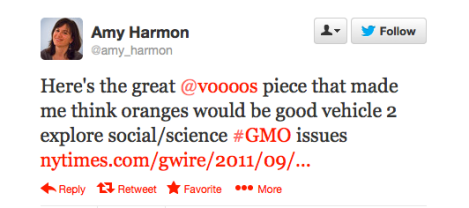It’s rare that us lowly eaters experience any personal gain from genetically modified food. But over the weekend The New York Times published a long piece by Amy Harmon that made the benefits of genetically modified oranges explicit.
That benefit? Having any oranges at all. An insect-spread disease, which turns oranges green and sour, is spreading throughout the world. Harmon quotes one scientist as saying:
People are either going to drink transgenic orange juice or they’re going to drink apple juice.
That may be a bit of an overstatement: Orange groves are succumbing fast, but growers are fighting back.
Growers in Florida did not like to talk about it, but the industry’s tripling of pesticide applications to kill the bacteria-carrying psyllid was, while within legal limits, becoming expensive and worrisome. One widely used pesticide had stopped working as the psyllid evolved resistance, and Florida’s citrus growers’ association was petitioning one company to lift the twice-a-season restrictions on spraying young trees — increasingly its only hope for an uninfected harvest.
Ricke Kress, president of Southern Gardens Citrus, is trying a different strategy: genetically modifying orange trees to resist the disease. It looks like he has succeeded. But Kress is haunted by the possibility that no one will want to drink his genetically engineered OJ.
“Will they believe us?” he asked himself for the first time. “Will they believe we’re doing this to eliminate chemicals and we’re making sure it’s safe? Or will they look at us and say, ‘That’s what they all say?’”
At least one reader did believe it. A New York commenter with the handle Ancient Astronaut wrote:
Genetically modified foods concern me, but I have to say that I’d prefer tested GM food over food soaked in pesticides any given day of my life. Genes, after all come from nature; chemicals don’t.
Aside from the fact that chemicals do, in fact, come from nature — everything in nature is made of chemicals! — this seems an apposite example: When people are faced with a problem, and genetic modification is one of several choices for dealing with that problem, we might just pick it. It’s a lot tougher to swallow when we have no choice, and the only benefit we see is to the bottom line of agribusiness.
Of course, many, many, other commenters weren’t convinced. As I read, I began to develop an inkling of an objection myself. It’s not as though this disease came out of nowhere. Kress is in a rush to find a quick fix and save his business, but the rest of us are under no such obligation. Sure, the proximate cause of citrus greening is a virus bacterium, and that begs for a cure. But it’s worth slowing down long enough to ask what the ultimate source of this problem is — and whether there might be a larger solution.
To see the bigger problem, you have to understand that the orange is a pure product of human modification. Harmon writes:
The orange, for its part, might never have existed had human migration not brought together the grapefruit-size pomelo from the tropics and the diminutive mandarin from a temperate zone thousands of years ago in China. And it would not have become the most widely planted fruit tree had human traders not carried it across the globe.
The orange is an utterly domestic fruit. That means there’s no pool of wild oranges to tap for new genetic variations. Orange seeds are usually genetically identical to their mother, making them hard to breed. And growers fill their groves with clones, each grafted onto a hardy rootstock. It would be hard to design a system more felicitous to disease.
As one friend put it, the impulse to reach for genetic engineering seems “lazy.” This friend, a scientist, thought it better to rethink the system, to look to polyculture (many species in a field) rather than monoculture (one species repeated over and over). In this case, we may need genetic engineering to get oranges to survive in any kind of agriculture because its genetic lineage is so narrow.
The point is that a lot of the resistance to GE food comes from the perception that it’s a solution, not to our problems, but to the problems of unsustainable agriculture. And so far, that perception has been mostly correct. There are exceptions, though, as detailed in this article by Paul Voosen (which, by the way, inspired Harmon’s piece).
The other big objection to Harmon’s piece was that people didn’t trust agribusiness to handle this technology. As another commenter put it:
I’d feel a lot better about GE food if I felt it was being tested properly by people without vested interests.
Even though the testing described in the piece is fairly extensive:
And when the E.P.A. informed [Kress] in June 2012 that it would need to see test results for how large quantities of spinach protein [to be genetically engineered into orange trees] affected honeybees and mice, he gladly wrote out the $300,000 check to have the protein made.
It was the largest single expense yet in a project that had so far cost more than $5 million. If these tests raised no red flags, he would need to test the protein as it appears in the pollen of transgenic orange blossoms. Then the agency would want to test the juice.
That’s a lot of testing, in my humble opinion. And yet, it’s conducted in a way that does not inspire confidence (i.e. companies in charge, confusing language, as I wrote about here).
Harmon does a nice job of addressing (and knocking down) many of the more unsophisticated arguments against GM food in this piece. Reading between the lines also offers a glimpse of the more legitimate complaints: People want to be able to weigh the costs and the benefits, they want crops that aren’t just a crutch for an unsustainable system, and they want an independent regulatory apparatus. There’s more to this than primal fear.
Update: I ascribed citrus greening to a virus — it’s actually thought to be a symptom of a bacterium. Sorry about the goof.





